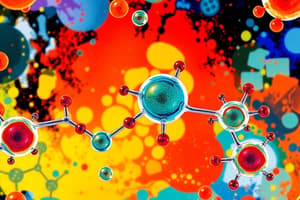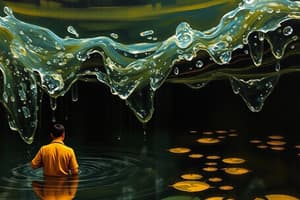Podcast
Questions and Answers
What is the significance of hydrogen bonds in water?
What is the significance of hydrogen bonds in water?
- They prevent water from forming crystalline structures.
- They decrease water's ability to dissolve polar biomolecules.
- They allow water to exist as a gas at higher temperatures.
- They contribute to the cohesive forces that keep water liquid at room temperature. (correct)
Which statement regarding the ionization of water is accurate?
Which statement regarding the ionization of water is accurate?
- The ionization of water is only significant at high temperatures.
- Water doesn't ionize and remains neutral at all times.
- Water ionizes to form carbonic acid and bicarbonate in biological systems.
- Water can ionize into hydrogen ions (H⁺) and hydroxide ions (OH⁻). (correct)
How do weak acids and bases behave in aqueous solutions?
How do weak acids and bases behave in aqueous solutions?
- They completely dissociate and do not act as buffers.
- They increase the concentration of OH⁻ ions in a solution.
- They can help maintain pH levels by neutralizing strong acids and bases. (correct)
- They do not influence the properties of other solutes present.
What role does water play in the self-assembly of biomolecules?
What role does water play in the self-assembly of biomolecules?
Why do polar biomolecules dissolve readily in water?
Why do polar biomolecules dissolve readily in water?
What percentage of the weight of most organisms is made up of water?
What percentage of the weight of most organisms is made up of water?
What happens to the molecular structure of water when it freezes?
What happens to the molecular structure of water when it freezes?
What aspect of water profoundly influences the properties of cellular components like proteins and nucleic acids?
What aspect of water profoundly influences the properties of cellular components like proteins and nucleic acids?
What is the reason for water's unusual properties, such as its high melting point and boiling point?
What is the reason for water's unusual properties, such as its high melting point and boiling point?
Why do nonpolar molecules tend to be poorly soluble in water?
Why do nonpolar molecules tend to be poorly soluble in water?
What is the bond angle in a water molecule?
What is the bond angle in a water molecule?
What is the bond dissociation energy for hydrogen bonds in liquid water?
What is the bond dissociation energy for hydrogen bonds in liquid water?
What effect does the electronegativity of oxygen have on the water molecule?
What effect does the electronegativity of oxygen have on the water molecule?
How do hydrogen bonds in liquid water compare to covalent bonds?
How do hydrogen bonds in liquid water compare to covalent bonds?
What defines the hydrophobic effect in aqueous solutions?
What defines the hydrophobic effect in aqueous solutions?
Which property of water is primarily affected by its hydrogen bonding?
Which property of water is primarily affected by its hydrogen bonding?
What type of interactions contribute to the three-dimensional structures of biomolecules?
What type of interactions contribute to the three-dimensional structures of biomolecules?
What happens to the internal cohesion of liquid water when hydrogen bonds are disrupted?
What happens to the internal cohesion of liquid water when hydrogen bonds are disrupted?
Flashcards
Water's abundance in living organisms
Water's abundance in living organisms
Water makes up a significant portion (70% or more) of most living organisms.
Role of water in early life
Role of water in early life
Early life forms likely arose and evolved in an aqueous environment.
Water's influence on cell function
Water's influence on cell function
Cell structure and function are adapted to water's physical and chemical properties.
Importance of weak water interactions
Importance of weak water interactions
Signup and view all the flashcards
Hydrogen bonds in water
Hydrogen bonds in water
Signup and view all the flashcards
Solubility of biomolecules in water
Solubility of biomolecules in water
Signup and view all the flashcards
Water's role in biomolecule recognition
Water's role in biomolecule recognition
Signup and view all the flashcards
Water's importance for biological buffering
Water's importance for biological buffering
Signup and view all the flashcards
Nonpolar biomolecules
Nonpolar biomolecules
Signup and view all the flashcards
Water solubility
Water solubility
Signup and view all the flashcards
Hydrogen bond
Hydrogen bond
Signup and view all the flashcards
Partial Charges
Partial Charges
Signup and view all the flashcards
Electronegativity
Electronegativity
Signup and view all the flashcards
Water's high melting/boiling point
Water's high melting/boiling point
Signup and view all the flashcards
Heat of vaporization
Heat of vaporization
Signup and view all the flashcards
Cohesion
Cohesion
Signup and view all the flashcards
Sp3 bonding orbitals
Sp3 bonding orbitals
Signup and view all the flashcards
Study Notes
Water's Abundance and Importance in Living Systems
- Water constitutes 70% or more of most organisms' weight.
- Early life arose in aqueous environments.
- Evolution has been shaped by water's properties.
- Cell structure and function are adapted to water's properties.
Water's Physical and Chemical Properties
- Water's attractive forces and ionization are vital to biomolecules.
- Ionization is reviewed using equilibrium constants, pH, and titration curves.
- Aqueous solutions of weak acids/bases and salts act as buffers against pH changes.
- Water molecules and their ions (H⁺ and OH⁻) influence cellular components (proteins, nucleic acids, lipids).
- Noncovalent interactions among biomolecules are significantly affected by water's solvent properties and hydrogen-bonding ability.
Weak Interactions in Aqueous Systems
- Hydrogen bonds between water molecules create cohesive forces, making water a liquid at room temperature.
- Crystalline water (ice) has an especially ordered structure due to hydrogen bonds.
- Polar biomolecules dissolve readily in water (replace water-water interactions with water-solute interactions).
- Nonpolar biomolecules disrupt water-water interactions and are poorly soluble (tend to cluster together).
- Hydrogen bonds, ionic bonds, hydrophobic interactions, and van der Waals forces collectively affect biomolecule structures.
Hydrogen Bonding in Water
- Water's high melting point, boiling point, and high heat of vaporization are a result of strong intermolecular attractions.
- Water's electron structure creates uneven electron sharing (oxygen is more electronegative).
- This results in water molecules having two electric dipoles, with partial positive charges on hydrogen and a partial negative charge on oxygen.
- Electrostatic attraction (hydrogen bond) forms between water molecules.
- Hydrogen bonds are relatively weak (bond dissociation energy ~23 kJ/mol compared to 470 kJ/mol for covalent O-H bond).
- Hydrogen bonds are represented with 3 parallel blue lines in the text
- The shape of the water molecule is nearly tetrahedral with a bond angle of 104.5 degrees.
Additional Information
- Examples of solvents (melting point, boiling point, heat of vaporization) are given in a table.
- Diagrams show the structure of the water molecule and hydrogen bonding.
Studying That Suits You
Use AI to generate personalized quizzes and flashcards to suit your learning preferences.




